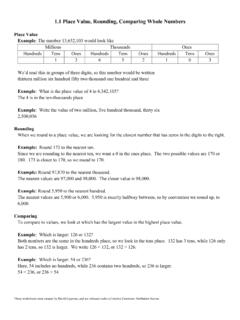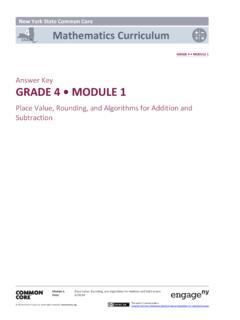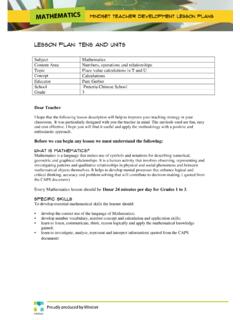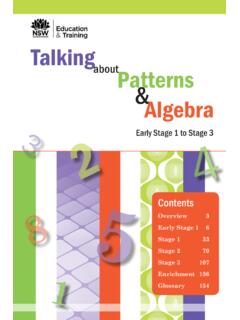Transcription of Grade One - Virginia Department of Education
1 Mathematics Standards of Learning for Virginia Public Schools September 2016 1 Grade One The first- Grade standards place emphasis on counting, comparing, and ordering sets of up to 110 objects; recognizing and describing simple repeating and growing patterns; and tracing, describing, and sorting plane figures. Students understanding of number is expanded through recognizing and describing part-whole relationships for numbers up to 10, solving story and picture problems using addition and subtraction within 20; using nonstandard units to measure; and organizing and interpreting data.
2 Fractional concepts will be expanded through sharing scenarios involving halves and fourths. The use of appropriate technology and the interpretation of the results from applying technology tools must be an integral part of teaching, learning, and assessment. While learning mathematics, students will be actively engaged, using concrete materials and appropriate technologies to facilitate problem solving. However, facility in the use of technology shall not be regarded as a substitute for a student s understanding of quantitative and algebraic concepts or for proficiency in basic computations.
3 The acquisition of specialized mathematical vocabulary and language is crucial to a student s understanding and appreciation of the subject and fosters confidence in mathematics communication and problem solving. Problem solving is integrated throughout the content strands. The development of problem-solving skills is a major goal of the mathematics program at every Grade level. The development of skills and problem-solving strategies must be integrated early and continuously into each student s mathematics Education .
4 Number and Number Sense The student will a) count forward orally by ones to 110, starting at any number between 0 and 110; b) write the numerals 0 to 110 in sequence and out-of-sequence; c) count backward orally by ones when given any number between 1 and 30; and d) count forward orally by ones , twos, fives, and tens to determine the total number of objects to 110. The student, given up to 110 objects, will a) group a collection into tens and ones and write the corresponding numeral; b) compare two numbers between 0 and 110 represented pictorially or with concrete objects, using the words greater than, less than or equal to; and c) order three or fewer sets from least to greatest and greatest to least.
5 The student, given an ordered set of ten objects and/or pictures, will indicate the ordinal position of each object, first through tenth. The student will a) represent and solve practical problems involving equal sharing with two or four sharers; and b) represent and name fractions for halves and fourths, using models. The student, given a familiar problem situation involving magnitude, will a) select a reasonable order of magnitude from three given quantities: a one-digit numeral, a two-digit numeral, and a three-digit numeral ( , 5, 50, 500); and b) explain the reasonableness of the choice.
6 Mathematics Standards of Learning for Virginia Public Schools September 2016 2 Computation and Estimation The student will create and solve single-step story and picture problems using addition and subtraction within 20. The student will a) recognize and describe with fluency part-whole relationships for numbers up to 10; and b) demonstrate fluency with addition and subtraction within 10. Measurement and Geometry The student will determine the value of a collection of like coins (pennies, nickels, or dimes) whose total value is 100 cents or less.
7 The student will investigate the passage of time and a) tell time to the hour and half-hour, using analog and digital clocks; and b) read and interpret a calendar. The student will use nonstandard units to measure and compare length, weight, and volume. The student will a) identify, trace, describe, and sort plane figures (triangles, squares, rectangles, and circles) according to number of sides, vertices, and angles; and b) identify and describe representations of circles, squares, rectangles, and triangles in different environments, regardless of orientation, and explain reasoning.
8 Probability and Statistics The student will a) collect, organize, and represent various forms of data using tables, picture graphs, and object graphs; and b) read and interpret data displayed in tables, picture graphs, and object graphs, using the vocabulary more, less, fewer, greater than, less than, and equal to. Patterns, Functions, and Algebra The student will sort and classify concrete objects according to one or two attributes. The student will identify, describe, extend, create, and transfer growing and repeating patterns.
9 The student will demonstrate an understanding of equality through the use of the equal symbol.













